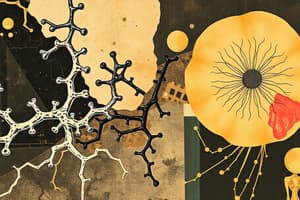Podcast
Questions and Answers
What percentage of dry weight in premolar and molar pulp is attributed to collagen?
What percentage of dry weight in premolar and molar pulp is attributed to collagen?
- 26% to 32% (correct)
- 15% to 20%
- 35% to 40%
- 10% to 15%
Which type of collagen is predominantly found in skin, tendon, and bone?
Which type of collagen is predominantly found in skin, tendon, and bone?
- Type II collagen
- Type V collagen
- Type I collagen (correct)
- Type III collagen
Which cells are responsible for synthesizing Type I collagen?
Which cells are responsible for synthesizing Type I collagen?
- Chondrocytes and fibroblasts
- Fibroblasts and odontoblasts (correct)
- Myocytes and osteocytes
- Neuron and epithelial cells
What is the initial product formed during collagen synthesis known as?
What is the initial product formed during collagen synthesis known as?
Which of the following statements correctly describes elastin fibers in the pulp?
Which of the following statements correctly describes elastin fibers in the pulp?
Which type of collagen is considered a fetal form and can be found in the dental papilla?
Which type of collagen is considered a fetal form and can be found in the dental papilla?
How is procollagen modified before it becomes tropocollagen?
How is procollagen modified before it becomes tropocollagen?
Which collagen types are primarily synthesized by fibroblasts?
Which collagen types are primarily synthesized by fibroblasts?
What is the role of the transcription factor SOX9 in dental pulp tissue?
What is the role of the transcription factor SOX9 in dental pulp tissue?
What aspect of tissue health does SOX9 seem to impact in dental pulp?
What aspect of tissue health does SOX9 seem to impact in dental pulp?
Which of the following is true about SOX9 in normal dental pulp tissue?
Which of the following is true about SOX9 in normal dental pulp tissue?
Flashcards are hidden until you start studying
Study Notes
Collagen and Elastin in Dental Pulp
- The pulp contains two primary structural proteins: collagen and elastin.
- Elastin is primarily found in the walls of arterioles and is not part of the extracellular matrix (ECM).
- Collagen is a major component of the pulp, making up 26% to 32% of the dry weight in premolars and molars.
- Collagen is composed of three polypeptide chains, designated as α-1 or α-2, forming a single molecule called tropocollagen.
- Type I and Type III collagen are the main types found in the pulp, with Type I present in thick striated fibrils throughout the tissue.
Collagen Types and Locations
- Type I collagen is found in various tissues, including skin, tendon, bone, dentin, and pulp.
- Type II collagen is present in cartilage.
- Type III collagen is found in most unmineralized connective tissues, including the dental papilla and mature pulp.
- Type IV and VII collagen are components of basement membranes.
- Type V collagen is a part of interstitial tissues.
- Type VI collagen is widely distributed in low concentrations in soft tissues and is involved in interfibrillar filaments.
Collagen Synthesis
- Odontoblasts and osteoblasts synthesize Type I collagen.
- Fibroblasts synthesize Types I, III, V, and VII collagen.
- Collagen synthesis begins with the formation of the protein portion of the molecule by polyribosomes in the rough endoplasmic reticulum (RER) of connective tissue cells.
- Proline and lysine residues in the polypeptide chains are hydroxylated in the RER cisternae.
- The chains assemble into a triple-helix configuration in the smooth endoplasmic reticulum, forming procollagen.
- Procollagen molecules are glycosylated and packaged in secretory vesicles within the Golgi complex.
- These vesicles are transported to the plasma membrane and released by exocytosis into the extracellular space.
- The terminal telopeptide of procollagen is cleaved by a hydrolytic enzyme, allowing tropocollagen molecules to aggregate and form collagen fibrils.
- Glycosaminoglycans (GAGs) are believed to play a role in mediating the aggregation of tropocollagen.
- Cross-linking of tropocollagen molecules leads to the conversion of soluble collagen into insoluble fibers.
Collagen in the Pulp
- SOX9, a transcription factor, is strongly expressed in normal pulp tissue and promotes collagen synthesis and ECM balance.
- Collagen fibers extend from the dentin matrix between odontoblasts into the dental pulp, particularly in fully erupted teeth.
- Larger collagen fiber bundles are more abundant in the radicular pulp than in the coronal pulp.
- The highest concentration of these larger bundles is typically found near the apex of the tooth.
SOX9 and Dental Pulp
- SOX9 is a transcription factor, which means it controls the expression of other genes.
- SOX9 is abundant in healthy dental pulp tissue.
- SOX9 expression is reduced in inflamed dental pulp.
- SOX9 appears to stimulate collagen production.
- SOX9 likely contributes to maintaining the balance of the extracellular matrix (ECM) in dental pulp.
Studying That Suits You
Use AI to generate personalized quizzes and flashcards to suit your learning preferences.




